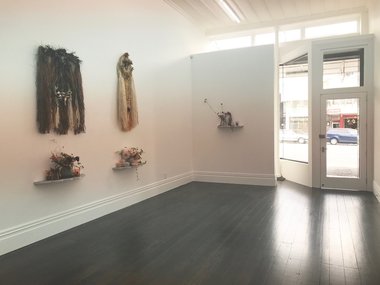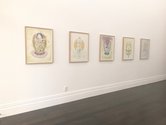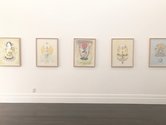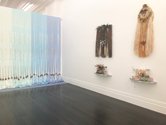John Hurrell – 13 February, 2018
Singh and her four collaborators (Ella Brewer, Geshe Thupten Wangchen, Alicia Courtney, and Isaac Katzoff) have used an impressive array of symbolic materials and artisanal techniques from all over the world: an eclectic selection of mineral or vegetable substances; animal body parts; valuable and valueless, permanent and transient materials— juxtaposed.
Auckland
Tiffany Singh
Collaboration is the Future
31 January - 24 February 2018
With a title that optimistically waves the flag for a particular artistic process (in opposition to the notion of the solitary individual doggedly pottering away in their studio)—an ethos that on a wider level seems crucial if life on our planet has any chance of survival—this show by Tiffany Singh presents (mostly) an array of Tibetan Buddhist iconography created using collective technical and conceptual participation. In this elegant installation we see a wall of vertical coloured ribbons bearing a holy mantra and each with a rattling bell, a suite of five very delicate devotional Tibetan-style images, (surprisingly) some North American (New Mexico) reliefs in the form of two talismanic shrines, and a ikebana-like arrangement incorporating a rainbow coloured, resin Buddha that is Thai in derivation. Overall, two-dimensional meditative mandala sensibilities are placed opposite tactile, votive sculpture.
Singh and her four collaborators (Ella Brewer, Geshe Thupten Wangchen, Alicia Courtney, and Isaac Katzoff) have used an impressive array of symbolic materials and artisanal techniques from all over the world: an eclectic selection of mineral or vegetable substances; animal body parts; valuable and valueless, permanent and transient materials—juxtaposed. To make a crude distinction about the geographic contrasts: it is contemplation and/versus supplication. Plus other artists like Tessa Laird and Richard Orjis have also contributed elements to the shrine components.
Singh’s Buddhist collaborations with Ella Brewer in six works are particularly fascinating. They involve the method of pressed pansy colour-transfer, featuring faint greys, mauves and pinks—highlighting intricate petal edges. Though inspired by the Buddhist traditions on the edge of the Himalayas, these works have no hint of the tantric hallmarks as popularly perceived: no leering demons, no necklaces of skulls, or deities having sex or skeletons committing acts of violence; no flickering flames from hell. They have a different more unified focus, like that of the conventional, more serene, Buddha portrait. The repeated pansy shapes bring a very different sort of mood, a gentler quieter ambience—an evanescent pulsing sense of the brevity of each individual life cycle or (if chronologically expanded) aeon.
As fetish objects the shamanistic New Mexico wall reliefs have great impact, being crammed with all sorts of unusual eye-catching ingredients, and this process is repeated in the detailed lists in the catalogue of the watery substances used to paint or print the form of the Buddha. These lists are not just sources of discretely sequenced symbolic information—they have an energy, a vitality, as flowing textual lines of signified mental images.
The mixture of materials here, and painting or sculpture methods—from diverse cultures—makes this show saliently refreshing. Its dismissal of geographic cultural purity and isolationism gives it an appealing vibrancy and unpredictability—a restless sense of multiple sites squeezed and jumbled up together. In the New Mexico (Santa Fe) works, the exotic animal parts include kaka feathers, coyote skulls, butterflies, horse hair, rabbit skulls, teeth, peacock feathers, hawk claws and sea egg spikes. Such ‘museum pieces’ are given life in a new sculptural synthesis. They acquire a new more strident presence collectively as one unit, as all fetish objects (and most art objects) must.
In contrast, with Singh’s Buddhas the use of pure silver or 23 carat gold on paper alongside diluted mud and fading flower dyes rams home questions about spiritual worth, economic value and the artwork’s physical longevity, and the symbolic implications for the reincarnating human soul residing within each viewer. The aim is efficacy. Practical function works alongside aesthetic sensibility, both unified in common pedagogical purpose.
John Hurrell















 Two Rooms presents a program of residencies and projects
Two Rooms presents a program of residencies and projects Advertising in this column
Advertising in this column



This Discussion has 0 comments.
Comment
Participate
Register to Participate.
Sign in
Sign in to an existing account.